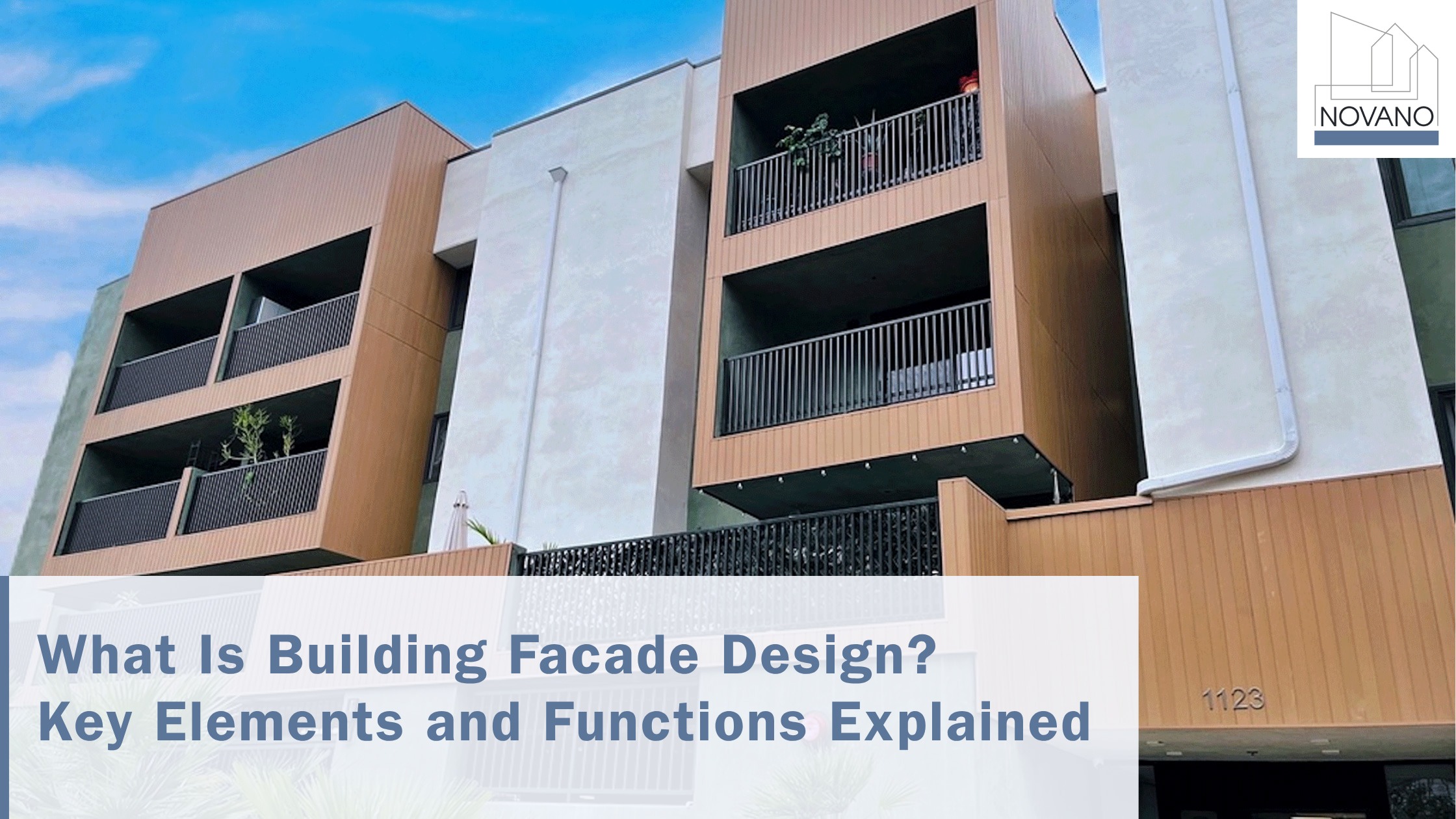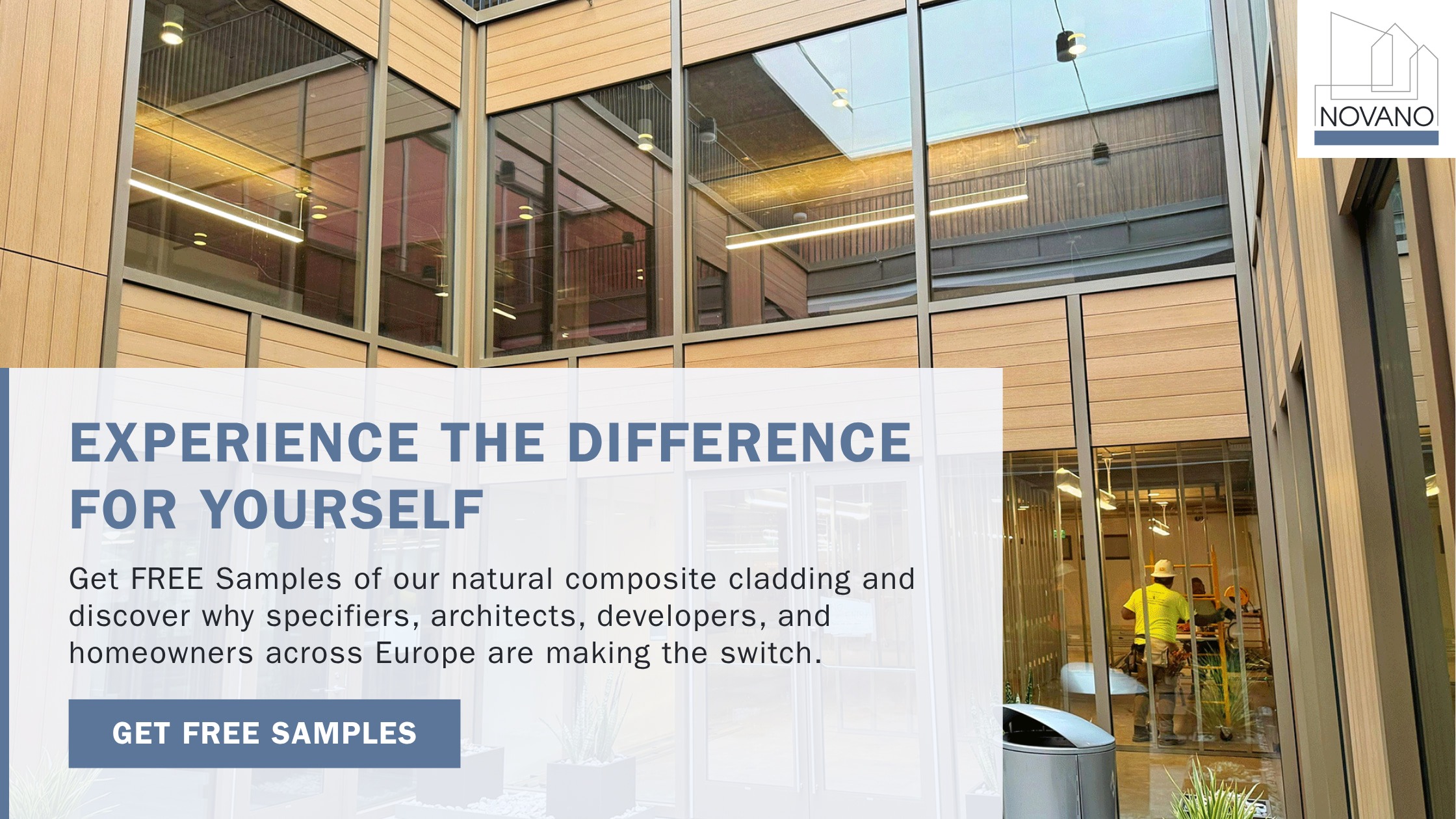
Summary
Building facade design blends aesthetics and performance to protect and define structures. This guide explains facade functions, essential materials, sustainable solutions, and current systems. Join us as we explore how facades impact energy efficiency and architectural identity in Germany, the United Kingdom, and across Europe.
- Summary
- Introduction to Building Facade Design
- Key Takeaways
- Core Functions of a Building Facade
- Key Elements of Modern Facade Design
- Common Facade Systems and Design Approaches
- Sustainable Materials and Future Trends
- Natural Composites and Low-Carbon Materials
- Circular Design and Lifecycle Thinking
- Smart and Responsive Facades
- Choosing the Right Facade for Your Project
- Aligning Design with Climate and Building Purpose
- Working with Architects and Material Partners
- Introducing a Hybrid Solution for Sustainable Facade Design
- The Future Is Facade-First
- FAQs
What Is Building Facade Design? Key Elements and Functions Explained
Introduction to Building Facade Design
A building facade is the exterior face or “skin” of a building. It’s the part people see first and often remember most. It combines art and science to create a surface that is not only beautiful but also serves vital protective and functional roles.
Facades influence a building’s style and how well it handles weather, sunlight, and energy use. Historically, facades have evolved from simple stone or brick walls to complex layers combining glass, metals, and composite materials. Today, sustainable design is central, with facades playing a key role in reducing energy consumption and environmental impact across Europe’s construction industry.
Key Takeaways
✓ Effective facade design achieves a harmonious balance between aesthetic appeal, functional performance, and environmental responsibility.
✓ Selecting the right materials plays a crucial role in extending a building’s durability and reducing its ecological footprint over time.
✓ Incorporating smart facade technologies prepares buildings for future demands in energy efficiency and occupant comfort.
✓ Sustainable siding options, such as those provided by Novano, deliver reliable performance while minimising environmental impact.
Core Functions of a Building Facade
#1 Environmental Protection
A facade is the building’s first line of defense:
- Weather Shield: It keeps out wind, rain, sun, and pollution.
- Thermal Control: Helps keep interiors warm in winter and cool in summer.
- Ventilation: Some facades, like ventilated facades, allow air to move behind the panels, reducing moisture and improving energy flow.
#2 Aesthetic Identity
A facade gives a building its personality:
- It can make a house feel warm and inviting.
- It can make a hotel or office look sleek, modern, and professional.
- In cities, facades help preserve cultural identity and local character.
#3 Structural Performance
While not always load-bearing, facades still play a structural role.
- They hold their own weight and resist pressure from wind or debris.
- They must meet fire safety and insulation codes.
- They often connect with other systems like HVAC, lighting, or security.
Key Elements of Modern Facade Design
#1 Material Selection
The choice of material matters: for looks, safety, and performance.
Material Type | Pros | Considerations |
Natural Composites (Novano) | ✓ Wood-free ✓ Low maintenance ✓ Fire-rated ✓ Weather-resistant ✓ Sustainable and Eco-friendly | ✕ Proper installation required |
Natural Wood | ✓ Warm and Classic look | ✕ High maintenance ✕ Can rot or warp |
Glass | ✓ Clean, modern, natural light | ✕ Heavy ✕ Poor insulation without coating |
Stone | ✓ Durable ✓ Timeless | ✕ Expensive ✕ Heavy |
#2 Energy Efficiency and Sustainability
Modern facades are designed to save energy.
- Thermal breaks reduce heat loss.
- Sun-shading elements block direct heat.
- Smart glazing reflects UV rays while letting light in.
According to the European Commission, such features are vital for greener buildings as buildings in the EU account for 40% of total energy use, making facade performance a key sustainability factor.
#3 Acoustic and Fire Performance
- In cities, good acoustic insulation blocks street noise.
- Fire ratings (like Class 1 by the British Standard) are essential for safety.
- Materials like Novano’s composite siding are Class 1 fire-rated and ideal for regulated environments.
Common Facade Systems and Design Approaches
Ventilated Facade Systems
These systems feature a gap between the exterior panel and the wall. Air circulates to reduce moisture and improve thermal comfort. Popular in both new builds and retrofits, especially where long-term durability matters.
Learn more about ventilated facades and their benefits.
Curtain Wall Systems
These are large panels, often made of glass or metal, hung on the building’s frame. Common in high-rise offices and hotels. These can be prefabricated (unitised) or built on-site (stick-built), allowing abundant natural light but requiring careful design to control solar heat.
Facade Retrofitting vs New Build
Updating old buildings with better facades helps meet energy and fire codes. Retrofitting is supported by programs like the UK Government’s Retrofit Strategy. Their guidelines offer best practices for upgrading facades. It’s more affordable than full rebuilds and makes historic buildings more future-ready.
Sustainable Materials and Future Trends
Natural Composites and Low-Carbon Materials
Materials like Novano’s wood-free composite siding boards cut reliance on timber and fossil-based plastics. Made from rice husks, minerals, and biobased polymers, they are fully recyclable and built to withstand harsh weather. Their long-lasting performance means fewer replacements and less waste over time. According to the Fraunhofer Institute, these types of materials help reduce carbon emissions across the full building lifecycle.
Circular Design and Lifecycle Thinking
Modern facade design increasingly follows circular principles, where materials are created to be taken apart and reused at the end of their service life. Panels can be removed, recycled, or repurposed, helping reduce landfill waste and extending the usefulness of valuable resources. Lifecycle assessments (LCAs) are often carried out to guide material choices, ensuring each component supports long-term environmental goals.
Smart and Responsive Facades
Some contemporary facades are designed to respond to changes in light, temperature, or air quality. These systems often use sensors connected to Building Management Systems (BMS) to make real-time adjustments. By automatically regulating shading, ventilation, or insulation, they help reduce energy waste while improving comfort for building occupants.
Choosing the Right Facade for Your Project
Aligning Design with Climate and Building Purpose
The right facade depends on:
- Location: Coastal areas need salt- and moisture-resistant materials.
- Climate: Germany’s cold winters vs the UK’s damp weather.
- Use: Homes may focus on insulation, while offices prioritise daylight and airflow.
Other considerations:
✓ Coastal, urban, and rural climates require different facade features; for example, more insulation inland, more humidity control near coasts.
✓ Regulations vary across Germany, the UK, and England, shaping material and performance standards.
Working with Architects and Material Partners
- Early coordination avoids costly mistakes.
- Clear specifications and precise detailing ensure design goals are met.
- Facade materials must be compatible with structural elements.
- Certifications ensure materials meet local codes for fire safety, energy performance, and sustainability claims.
Introducing a Hybrid Solution for Sustainable Facade Design
NOVANO Building Products Europe provides composite facades that are:
- Made from renewable rice husks, minerals, and biobased polymers.
- 100% wood-free, low-maintenance, and recyclable
- Class 1 Fire-Rated by the British Standard and weather-resistant
- Ideal for ventilated facades
- Backed by technical guides and easy Get FREE Samples ordering
Novano profiles are used across residential, commercial, and hospitality siding projects, combining modern design with long-term performance.
The Future Is Facade-First
Building facades are much more than just walls; they are dynamic interfaces balancing beauty, protection, and energy efficiency. Embracing modern materials and innovative systems unlocks potential for long-lasting, sustainable architecture.
With partners like NOVANO Building Products Europe, opting for high-performance, recyclable facade elements is easier than ever. Explore Novano’s offerings to combine durability with design excellence and contribute to Europe’s greener buildings.
FAQs
What is a building facade?
It’s the outermost layer of a building. It protects the inside from weather and defines the building’s style. A facade also plays a key role in how the building interacts with its surroundings, influencing energy efficiency, comfort, and visual impact.
What are the main functions of a building facade?
A well-designed facade enhances energy efficiency, comfort, safety, and visual appeal while contributing to the building’s overall lifespan. It serves as a barrier against weather, manages heat transfer, sunlight, and ventilation, and shapes the building’s identity. By controlling energy flow, it directly impacts heating, cooling, and long-term operating costs.
What are the best materials for sustainable facades?
Sustainable options include low-carbon composites, recycled materials, timber alternatives, and smart glazing. Natural composites, such as Novano’s profiles, are wood-free, highly durable, and fully recyclable. They withstand harsh weather, maintain their appearance over time, and meet strict fire safety standards.
Can I retrofit a facade on an older building?
Yes. Retrofitting can improve energy efficiency, insulation, and fire safety without changing the entire structure. It is often more cost-effective than a full rebuild, making it a practical way to update performance and appearance.

